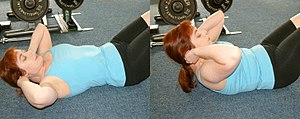Crunch (exercise)

The crunch, also known as curl-up, is one of the most common exercises for the abdominal muscles, primarily the rectus abdominis. It is considered a safer alternative to the sit-up[1].
Form
Proper starting form is lying face up on the floor with knees bent. The movement begins by curling the shoulders towards the pelvis, with hands placed behind or beside the neck, or crossed over the chest. Using the hands to exert force on the neck can cause injury, so common practice is to avoid placing the hands behind the head itself. The hands can however, form a shelf to support the weight of the head, so that the neck flexor muscles can relax during the movement. So long as the neck remains in an extended position with the neck flexors relaxed, then the hands are not exerting excessive force and it will not cause injury.
Crunches are not the same as sit-ups.
Alternatives
Crunch exercises may be performed on exercise balls. Weights may be used, typically held under the chin, to increase resistance. Increasing the distance will also increase the load on the abdominals due to leverage.
Differences between a crunch and a sit-up
Unlike the sit-up, when performing a crunch the lower back should not leave the floor. This is said to eliminate any involvement by the hip flexors, and make the crunch an effective isolation exercise for the abdominals. The difficulty of the crunch can be increased by lying on a declined bench and/or holding a weight on the chest or behind the head.
Types of crunches
Variants include:
- The reverse crunch or dragon flag (popularized by Bruce Lee and also Sylvester Stallone in his movie Rocky 4). Begin lying horizontal on a bench. The arms are used to hold the underside of the bench to anchor the shoulders to it to prevent rolling forward. The rest of the body inferior to the scapulae is then pulled from the bench. Beginning with legs flexed, the legs can be extended slowly to increase the difficulty of the movement (and tension on the core muscles) due to moving the weight further from the levers. Throughout the movement the legs and hips are meant to remain locked while movement occurs in the abdominal region. http://www.youtube.com/watch?v=vCjHLu46ucA
- The twisting crunch is performed by lifting one shoulder at a time. More emphasis is placed on the obliques.
- The Thai Crunch is performed by hitting the stomach after full contraction. This variation is used by Muay Thai fighters to condition the core to take hits from punches or knees.
- The cable crunch is performed while kneeling upright by curling the body to pull down on a cable machine. The hips are kept motionless, so the bodyweight does not assist the movement.
- The bicycle crunch is performed by bringing together alternating elbows and knees, resulting in a leg motion similar to pedaling a bicycle.
References
- ^ McGill, Stuart. Low Back Disorders: Evidence-based Prevention and Rehabilitation. Human Kinetics Publishers. ISBN 978-0736066921.
